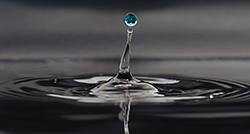
There is a lot of irony in the separation of oil and water. First of all, oil and water don’t mix. Surface tension eternally divides them. Then, oil always floats on top of water, because oil is lighter. Yet we get major oil spills and we get oil contamination on land and the restoration of the oil and the water from the process is always such a problem. The problem is that agitation of the oil and water mixture quickly causes the two to form an emulsion, where the oil forms smaller and smaller globules within the water. Essentially the fluid retrieved in the cleanup becomes a single substance.
Emulsifiers are often used in oil cleanups. However, the emulsifiers are themselves an environmental hazard. In addition, the process of emulsification is exactly the reduction of the oil mass into microscopic globules which get suspended in the water.
Although the oil is never dissolved in the water, once emulsified the globules of oil are microscopic in size and even pass through fine filters. No matter what the size of the globules, the oil makes the water virtually unusable, a poisonous biohazard. These problems occur in ocean oil spills, but also in the cleanup of oil from fleet garage floors and industrial settings. Often in oil spill disaster, the oil appears to have disappeared, but actually the same mass of oil has emulsified into suspension within the water.
Shell Oil and other industrial stakeholders have been working on the development of graduated pore filters in the form of membranes. The pores can be made small enough to block microscopic oil globules when the water-oil emulsion is forced through the membrane. The membrane itself is manufactured with special chemical properties to repel both oil and water. Demonstrations have shown that oil can be recovered at the top of the membrane and water emerging from the bottom of the membrane is clear. However, this membrane solution needs further development. Currently, the membrane is not strong enough to withstand even nominal real life pressures.
Vacuum and centrifuge systems are currently in use. These systems vacuum the oil-water emulsion and pass it through a high speed centrifuge which forces the heavier water toward openings on the outer circumference. The oil, remaining in the center of the centrifuge can be returned to use as essentially pure. The water recovered from the centrifuge is never completely clean, however.
Industrial oil water separators are employed to control the environmental impact of waste oil cleanups in commercial garages and factory settings. These consist of filter systems installed in drainage systems. The filters separate the oil and water before emulsification takes place. Waste oil and oil-based substances are emptied into underground tanks. Vactone Environmental Services specializes in the maintenance of oil water separation systems and the safe disposal of hazardous oil waste products. Contact us
